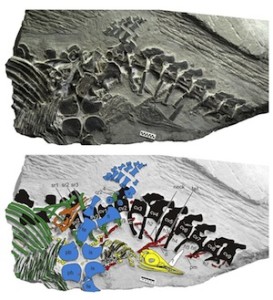By Sanne van den Tol
UCR Class of 2016
Finding fossils of dinosaur infants is one thing, but finding a fossil of a dinosaur in labor is taking things to a whole new level. However, on the 12th of February a group of scientists published their findings in PLOSone of just such an event. Moreover, the fossil was not only that of a dinosaur in labor, but that of a marine “reptile”. Not much is known about (marine) dinosaur labor, but this find could show whether marine dinosaurs were viviparous (giving live birth, as opposed to laying eggs) and whether this happened on land or in water.

The fossils were found in China and were specified as Chaohusaurus, which is one of the three genera in the Ichtyopterygian family and also one of the oldest. As seen in the picture, only part of the maternal skeleton was found. However, one articulated (which means the bones of the skeleton are roughly in the same position as they would be if the dinosaur were still alive) embryo, colored yellow, one almost articulated embryo, colored orange, and one infant, colored red, were found as well. The first embryo, the yellow-colored one, is wedged in the maternal pelvis, headfirst. This last detail is what makes this find is so interesting: most marine animals give birth tail-first.
Multiple questions may arise from the layout of the fossil, such as if this could have been a breech birth? Scientists have concluded that this was not the case, because the other embryo, the orange one, is also positioned headfirst. The possibility of two breech births in one litter is incredibly unlikely. Additionally, there are few examples of head-first water births, even though they are air-breathers, such as the white whale. Furthermore, the fossil evidence suggests the Chaohusauruses died underwater. These last two explanations are also two of the reasons the scientists suggest that the Ichtyopterygian family gave birth underwater, as opposed to a terrestrial birth.
Underwater viviparity, or underwater birth, in marine reptiles was first believed to have evolved independently (convergent evolution), now, however, scientists are unsure. The possibility exists that viviparity may have evolved from their terrestrial ancestors instead. Comparing this with extant species (the opposite of extinct) scientists may say the latter is indeed true. The origin of viviparity in contemporary marine amniotes (species with a placenta, and thus viviparity) is also still unclear. It is now believed that marine amniotes derived from terrestrial ancestors, as terrestrial viviparity had an advantage over marine viviparity as a result of larger temperature variations (temperature in water is quite constant), which led to viviparity as the offspring then had a bigger chance of survival.
In addition, it is important to note that a recent molecular phylogenetic study showed that an ancestor of a part of a viviparous group was terrestrial. Therefore the scientists concluded that the viviparity in the Ichtyopterygian family also most likely derived from terrestrial ancestors, which is the conclusion that will be accepted, at least for now.
Sanne van den Tol, class of 2016, is a Science major from Halsteren, The Netherlands
